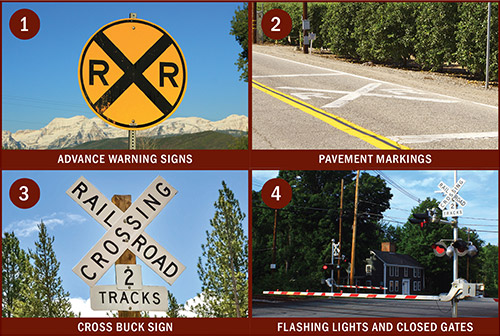Understanding Railroad Crossings
Definition of Railroad Crossings
Railroad crossings are intersections where roadways meet railway tracks. These crossings can be marked with various safety devices, including signs, lights, and gates, to warn drivers and pedestrians of oncoming trains. Understanding the layout and signals at these crossings is vital for ensuring safety.
Types of Railroad Crossings
- Public Crossings: These are crossings that are open to the public and typically equipped with warning signals and gates.
- Private Crossings: These crossings are located on private property and may not have the same level of safety equipment as public crossings.
- Grade Crossings: These are crossings where the railway and roadway are at the same level.
- Overpasses and Underpasses: These structures allow vehicles to pass over or under railway tracks without intersecting them.
The Dangers of Railroad Crossings
Statistics on Railroad Crossing Accidents
Railroad crossings can be hazardous, with thousands of accidents occurring each year. According to the National Highway Traffic Safety Administration (NHTSA), in 2021, there were over 1,600 collisions between vehicles and trains, resulting in 133 fatalities and 644 injuries.
Common Causes of Accidents
- Ignoring Warning Signals: Many accidents occur when drivers fail to heed warning signals, such as flashing lights or lowered gates.
- Misjudging Train Speed: Trains can appear to be moving slowly, leading drivers to misjudge the time they have to cross.
- Distracted Driving: Distractions from electronic devices or passengers can prevent drivers from paying attention to their surroundings.
- Stalled Vehicles: Vehicles that stall on the tracks are at high risk of being struck by trains.
Safety Tips for Approaching Railroad Crossings
General Guidelines
- Stay Alert: Always be vigilant when approaching a railroad crossing. Look for warning signs and listen for train horns.
- Obey All Signals: Follow all posted signs and signals. If the lights are flashing or the gates are down, stop and wait for the train to pass.
- Stop at a Safe Distance: When stopping for a train, ensure you are at least 15 feet away from the tracks to allow enough space for the train to pass safely.
- Look Both Ways: Before crossing, look in both directions to ensure no trains are approaching. Remember that trains can come from either direction.
- Never Stop on the Tracks: Ensure that your vehicle has enough room to clear the tracks before proceeding. If traffic is backed up, do not enter the crossing.
- Be Cautious in Low Visibility: In fog, rain, or darkness, reduce your speed and increase your vigilance when approaching crossings.
Specific Actions at Railroad Crossings
| Action | Description |
|---|---|
| Stop, Look, and Listen | Always stop before the crossing, look both ways, and listen for any approaching trains. |
| Obey Warning Signs | Pay attention to all signals, including flashing lights, bells, and lowered gates. |
| Keep Your Vehicle Maintained | Ensure your vehicle is in good working condition to prevent stalling on the tracks. |
| Educate Children | Teach children about the dangers of railroad crossings and the importance of following safety rules. |
| Use Designated Crossings | Always cross at designated pedestrian crossings and obey all traffic signals. |
What to Do If Your Vehicle Stalls on the Tracks
If your vehicle becomes stuck on the tracks, follow these steps:
- Exit the Vehicle Immediately: Quickly get out of the vehicle and move away from the tracks.
- Call for Help: Dial 911 or the emergency number listed on the blue emergency notification sign located at the crossing.
- Stay Clear of the Tracks: Move at least 100 feet away from the tracks to avoid being struck by debris if a train approaches.
- Do Not Attempt to Push the Vehicle: Trying to move a stalled vehicle can be extremely dangerous, especially if a train is approaching.
Legal Responsibilities and Penalties
Understanding Traffic Laws
Each state has specific laws regarding railroad crossings. It is crucial to familiarize yourself with these regulations to avoid legal consequences. Common violations include:
- Failing to Stop: Not stopping at a crossing when required can lead to fines and points on your driving record.
- Driving Around Gates: Attempting to drive around lowered gates is illegal and can result in severe penalties.
Penalties for Violations
Penalties for violating railroad crossing laws can vary by state but may include:
- Fines ranging from $100 to $1,000 or more.
- Points added to your driving record.
- Possible suspension of driving privileges.
FAQ Section
What should I do if I see a train approaching the crossing?
If you see a train approaching, stop at a safe distance, wait for the train to pass, and do not proceed until the lights stop flashing and the gates are fully raised.
How can I tell if a train is coming?
Look for warning signs, flashing lights, and lowered gates. Additionally, listen for train horns or whistles.
Is it safe to cross if the lights are not flashing?
No, you should never assume it is safe to cross if the lights are not flashing. Always look both ways and be cautious.
What is the minimum distance I should stop from the tracks?
You should stop at least 15 feet away from the tracks when approaching a railroad crossing.
Can I drive around lowered gates?
No, it is illegal and extremely dangerous to drive around lowered gates. Always wait for the gates to rise before crossing.
What should I do if my vehicle stalls on the tracks?
Exit the vehicle immediately, move away from the tracks, and call 911 for assistance.
Are there any specific laws regarding railroad crossings in my state?
Yes, each state has its own laws regarding railroad crossings. Check your state’s Department of Transportation website for specific regulations.
How often do accidents occur at railroad crossings?
Accidents at railroad crossings occur frequently, with thousands of collisions reported each year. Staying informed and cautious can help reduce these incidents.
What are the consequences of ignoring railroad crossing signals?
Ignoring railroad crossing signals can result in fines, points on your driving record, and serious accidents that can lead to injury or death.
How can I educate my children about railroad safety?
Teach your children to always obey warning signs, look both ways before crossing, and never play near the tracks. Use educational resources and practice safe crossing behaviors together.
Conclusion
Approaching a railroad crossing requires vigilance, awareness, and adherence to safety protocols. By understanding the dangers associated with railroad crossings and following the recommended guidelines, drivers and pedestrians can significantly reduce the risk of accidents. Remember to always stop, look, and listen when approaching a crossing, obey all signals, and never take unnecessary risks.For further information on railroad crossing safety, you can refer to the following resource: Wikipedia – Railroad Crossing.This guide serves as a comprehensive resource for understanding and practicing safe behaviors at railroad crossings, ensuring that you and your loved ones remain safe while navigating these critical intersections.



